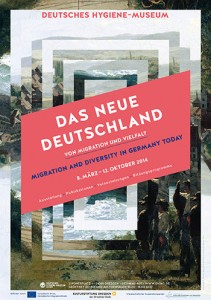New Issue of TRANSIT
 “TRANSIT: A Journal of Travel, Migration, and Multiculturalism in the German-speaking World” is pleased to announce the publication of the first installment of texts in the 2013-14 volume: an excerpted translation of Ali’s Kürk Mantolu Madonna (The Madonna in the Fur Coat, 1943) and selections from the exhibition on “Das neue Deutschland. Von Migration und Vielfalt” (The New Germany: On Migration and Diversity, 2014).
“TRANSIT: A Journal of Travel, Migration, and Multiculturalism in the German-speaking World” is pleased to announce the publication of the first installment of texts in the 2013-14 volume: an excerpted translation of Ali’s Kürk Mantolu Madonna (The Madonna in the Fur Coat, 1943) and selections from the exhibition on “Das neue Deutschland. Von Migration und Vielfalt” (The New Germany: On Migration and Diversity, 2014).
The exhibition on “Das neue Deutschland,” featuring UC Berkeley’s Multicultural Germany Project, is currently on display until October 12, 2014 at the Deutsches Hygiene-Museum in Dresden. If you are able to visit the exhibition in Dresden, we would love to hear your thoughts and see any photos you might happen to take (transitjournal@berkeley.edu). If you are unable to visit the exhibition, you can still purchase a copy of the excellent book on the exhibition, edited by Özkan Ezli and Gisela Staupe, and read a translation of their introduction on “Diversity as Social Utopia.” Our selections from this book should give you a sense of the exhibition’s conceptual range: “Asylum” (Heribert Prantl); “Baggage” (Deniz Utlu); “The Future of Migration” (Jochen Oltmer); “Guest Faces” (Emine Sevgi Özdamar); “Integration” (Albert Koschorke); “Mobility” (Gisela Welz); “Multiculturality” (Claus Leggewie); “Nation” (Wolfgang Kaschuba); and “Transit” (Deniz Göktürk).
As the curators of the exhibition emphasize, migration is a historical rule, rather than an exception, as should also be evident in the excerpts from David Gramling and Ilker Hepkaner’s new translation of Sabahattin Ali’s 1943 novel Kürk Mantolu Madonna (The Madonna in the Fur Coat). Kristin Dickinson’s introduction to the translation, “Translating Surfaces: A Dual Critique of Modernity in Sabahattin Ali’s Kürk Mantolu Madonna” situates the novel in the context of pre-World War II Istanbul, and argues that the “story forms the basis for a critique of Turkish modernity through a critical engagement with Weimar surface culture.” The translation should be of interest not only to scholars working on Weimar Germany but also to those working on the concept of world literature and problems of cultural translation.
Rounding off the first installment of texts in our 2013-14 volume is Ashwin Manthripragada’s review of Nicholas A. Germana’s The Orient of Europe: The Mythical Image of India and Competing Images of German National Identity. We are adding this review to our previous feature on “Orienting Europe,” and we would like to remind you that we are encouraging further submissions on topics listed in the back issues of our journal. Each of these volumes will remain a discrete unit in the eScholarship repository, while we are continuing to create new constellations out of archival and current materials on our own website.
We would also like to remind you that we continue to invite rolling submissions, including translations, articles, and multimedia projects, and we always welcome suggestions for collaborations with guest editors. In fact, the second installment of texts in this issue will be a series of articles on “Contemporary (Re)Mediations of Race and Ethnicity in German Visual Cultures,” guest edited by Angelica Fenner and Uli Linke. We hope you enjoy the first round of texts in our 2013-14 volume, and we look forward to possibilities for future collaboration and exchange.
Sincerely,
Erik Born, on behalf of the editors of TRANSIT
